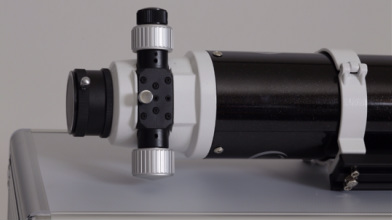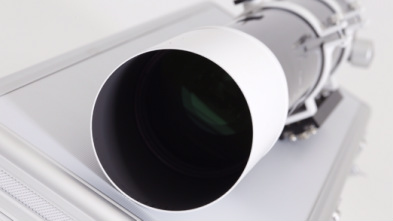Sky-Watcher 100ED Doublet
By Daniel ‘DoctorD’ Mounsey

INTRODUCTION
I’m astonished at how much people get so wrapped up about doublets vs triplets when they really don’t have to go with triplets in the first place. For just several hundred dollars, these doublets can be purchased and there’s a ton of value. They deliver fantastic optical performance at any price, even if they were three times their own cost! Triplets are more sophisticated and require very good care to maintain in order to avoid coming out of collimation, and they are often heavier. This SkyWatcher 100ED refractor weighs in at a feathery 10 pounds or so, which means it’s easier to mount and easier to transport.
If you feel that imaging is your forte, then SkyWatcher USA offers the optional Esprit edition with heavier duty focusers for CCD’s and cameras as well as faster F-‐ratio’s. Unlike most people, I have had the opportunity to test and compare many telescopes, (See here: 4 inch Hyper Shootout ) and I sincerely mean what I’m saying about this inexpensive 100ED.
MECHANICS & ACCESSORIES

When I added up all the features from front to rear on this refractor, it was difficult to argue against it. The course and ultrafine focuser are buttery smooth in-‐every regard. When I opened the case, I was astonished out how much I was looking at for the money or any money for that matter. It came with a 5mm and 20mm eyepiece,
8×50 RA finder, 2” star diagonal with 2” to 1.25” adapter, tube rings, dove plate, and hard carrying case. There’s really nothing you need to add right out of the box. Just put it on the mount and you’re done. Sky-Watcher USA also offers excellent customer support for technical issues if you encounter any.
OPTICAL PERFORMANCE

For me, this is what I really look at. This is a 900mm F/9 100mm ED doublet utilizing FPL-‐53 glass. Think about this for a moment. At F/9 the first thing you will notice is how flat the field is with corrected wide field eyepieces. Even at F/9, you still get a huge Richfield view with all the flatness because it’s only a 900mm focal length. Think about that for a moment, it’s a win-‐win situation. During my observations, I could pull in all six stars in Orion’s Trapezium. This is a target I often test scopes on because if the telescope has too much spherical aberration, the E and F components will get washed out. Even on Jupiter I could resolve several bands and structure as well as the Great Red Spot.
This refractor provided excellent optics at ANY price. Even the eyepieces, which are included, provided the proper magnifications one would use for planets and deep sky for a telescope of this aperture. I’ve been a member of the CloudyNights forums for many years in fact I’m one of the longest standing contributors. I have shared and conducted countless reviews on all fronts, whether it was eyepieces, Newtonians or refractors. One of the things I get so tired of listening to, is a 50 page dissertation about glass types, wave fronts and optical mechanic people who haven’t spent much time behind an eyepiece and really seeing for themselves how telescopes actually perform or compare. There’s no excuse for it and people need to start using some common sense. This is a hobby to enjoy, not a lab experiment and it really gets old after a while.

There will always be haters out there no matter what the product is and I’ve reached a point where I can literally count the number of people I listen to anymore when it comes to telescopes. There’s so much nonsense and crap to gargle on the Internet these days, it’s painfully obvious who’s, actually observing and who’s not. The key to enjoying any telescope is to know yourself better, so you can figure out what it is you really love to view with your telescope. The failure to do so will always be the Achilles heel of the observer. It isn’t the telescope I blame; it’s the observer. Once you understand what these telescopes are good for, that’s when you’ll begin to enjoy them. I happen to enjoy viewing the Moon, planets, carbon stars, asterisms, variable stars, multiple star systems, star clouds, extended nebula on a dark night and a countless array of peculiar star clusters. That’s what I like to see and that’s what this telescope delivers. Case closed.
